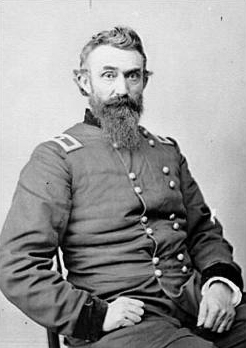Nathan Kimball facts for kids
Quick facts for kids
Nathan Kimball
|
|
|---|---|

Nathan Kimball
|
|
| Born | November 22, 1822 Fredericksburg, Indiana |
| Died | January 21, 1898 (aged 75) Ogden, Utah |
| Place of burial |
Aultorest Memorial Park, Ogden, Utah
|
| Allegiance | Union |
| Service/ |
Union Army |
| Years of service | 1846–1847, 1861–1865 |
| Rank | |
| Commands held | 14th Indiana Infantry Regiment Gibraltar Brigade |
| Battles/wars | American Civil War |
Nathan Kimball (born November 22, 1822 – died January 21, 1898) was an important figure in American history. He was a doctor, a politician, and a postmaster. He is best known for serving as a general in the Union Army during the American Civil War. He also led the first statewide group for Civil War veterans in Indiana, called the Grand Army of the Republic.
Contents
Early Life and First Career Steps
Nathan Kimball was born in Fredericksburg, Indiana, a small town. He went to local schools and then attended Indiana Asbury College (now DePauw University) from 1839 to 1841. After college, he worked as a teacher and farmer in Independence, Missouri.
In 1844, he studied medicine at the University of Louisville Medical School. He then opened his own doctor's office in Salem and Livonia. He married Martha A. McPheeters in 1845, and they had a son named James.
Serving in the Mexican-American War
When the Mexican–American War started, Dr. Kimball volunteered to serve. He formed a company of soldiers from Livonia and was chosen as their captain. He showed great bravery at the Battle of Buena Vista. Even when other soldiers ran away, he kept his company together and held their position.
After the war, he returned to Indiana in 1847 and continued his medical work. He tried to become a politician but lost elections in 1847 and 1852. In 1854, he joined the new Republican Party. His medical practice grew, and he became well-known. His first wife passed away in 1850, and he married Emily McPheeters later that year.
Civil War Service
When the American Civil War began in 1861, Kimball again volunteered. He raised a group of infantry soldiers. On June 7, 1861, Indiana's Governor Oliver Morton made him the colonel of the 14th Indiana Infantry Regiment. He led his soldiers in battles in western Virginia, fighting for the first time at the Battle of Cheat Mountain.
Key Battles and Promotions
In March 1862, Kimball fought in the Shenandoah Valley. He led a brigade at the First Battle of Kernstown. During this battle, he took command of a larger group of soldiers when his general was hurt. He then successfully pushed back Confederate General Stonewall Jackson. This was one of the first times Jackson had been defeated. Because of his excellent leadership, Kimball was promoted to brigadier general in April 1862.
In July 1862, Kimball's soldiers joined the Army of the Potomac. He helped cover the retreat of Union forces after the Second Battle of Bull Run.
The "Gibraltar Brigade"
During the Maryland Campaign, Kimball led a brigade in the II Corps. His men fought bravely at the Battle of Antietam. They attacked the Sunken Road, losing over 600 men. Despite heavy losses, they held their ground and pushed back the Confederates. They even captured 300 enemy soldiers. Kimball's brigade became famous for their toughness and was called the "Gibraltar Brigade".
In December, his men were part of the difficult attacks at Marye's Heights during the Battle of Fredericksburg. Kimball was badly wounded in the thigh and was out of action for several months. His brigade was then led by another officer. In 1863, he was asked to run for Lieutenant Governor of Indiana, but he chose to stay in the army.
Later War Campaigns
After recovering, Kimball was sent to the Western Theater of the war in June 1863. He commanded a division during the Siege of Vicksburg, though his troops arrived late for most of the fighting. Later, his division moved to Arkansas.
In April 1864, Kimball joined General William T. Sherman, who became a good friend. Kimball commanded a brigade and then a division during the Atlanta Campaign. He returned to Indiana briefly to help the governor with local issues. In late fall, he returned to active duty. He served as a division commander in the important battles of Franklin and Battle of Nashville. On February 1, 1865, he was given the honorary rank of brevet major general. He left the army on August 24, 1865, after the war ended.
Life After the War
After the Civil War, Nathan Kimball went back to Indiana. He became involved with the Grand Army of the Republic, a new organization for Civil War veterans. He was their first state commander.
He also returned to politics. In 1867, he was elected as the State Treasurer, where he worked on improving banking. He was re-elected for a second term. In 1869, he joined the Freemasons. In 1873, he was elected to the Indiana House of Representatives.
Later in 1873, President Ulysses S. Grant appointed Kimball as the Surveyor General for the Utah Territory. He held this position until 1878. The next year, President Rutherford B. Hayes made him the Postmaster of Ogden, Utah, which became Kimball's new home. He served as postmaster until he passed away in 1898. Nathan Kimball was buried in Ogden, Utah.
Honors
In 1915, a bronze statue of Nathan Kimball was placed in the Vicksburg National Military Park.

